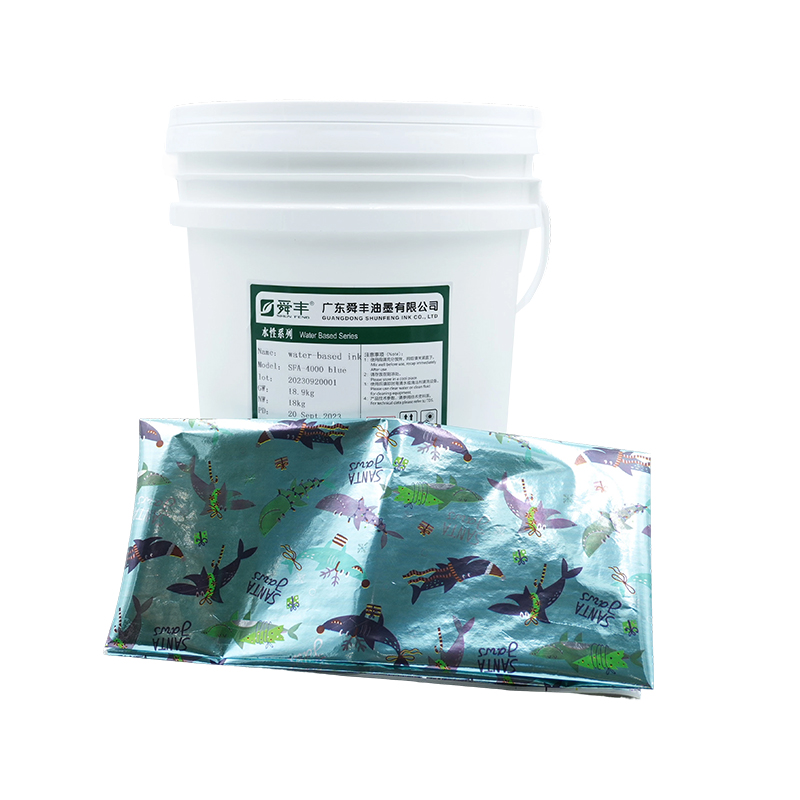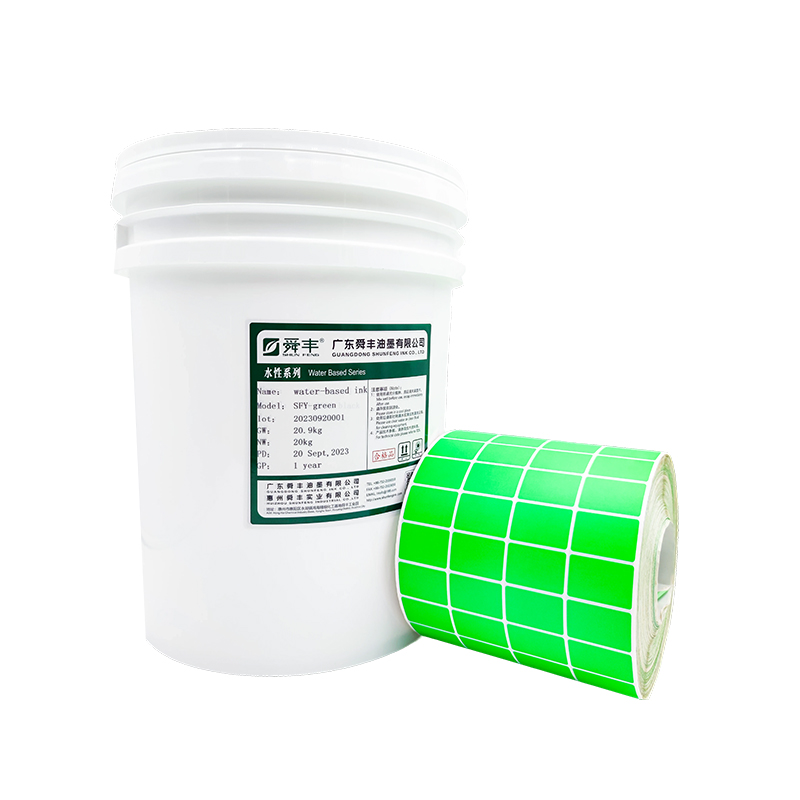Flexo water-based pre-printing ink's strategy to maintain color stability during high-speed printing
Release Time : 2025-03-20
In the modern printing industry, flexographic printing technology has gradually become the mainstream choice in the field of packaging printing with its environmental protection, high efficiency and high quality. Especially in the high-speed printing process, the application of flexo water-based pre-printing ink provides a strong guarantee for the color stability and expressiveness of printed products.
1. Characteristics of flexo water-based pre-printing ink
Flexo water-based pre-printing ink uses water as a dissolving carrier, which is environmentally friendly, non-toxic and harmless, and meets the current urgent needs for reducing carbon footprint and environmentally friendly printing. Its excellent physical properties, ink adhesion and high-definition dots make the gradation reproduction performance excellent, the ink color is bright and firmly attached, which is very suitable for the printing needs of fine products. In addition, flexographic water-based ink also shows low energy consumption and good printability. It has low and stable viscosity, is not easy to paste the plate, has a moderate ink layer thickness, fast curing speed, and the electricity required for curing is much lower than traditional thermal curing.
2. Challenges of color stability during high-speed printing
During high-speed printing, the color stability of ink faces many challenges. First, the high-speed operation of high-speed printing machines may cause instability of ink during the transfer process, thus affecting the color consistency of printed products. Second, the interaction between ink and substrates may also cause color changes, especially on substrates of different materials and thicknesses. In addition, environmental factors such as temperature and humidity may also affect the color stability of ink.
3. Strategies for maintaining color stability
Ink selection and blending: Selecting high-quality flexo water-based pre-printing ink is the basis for maintaining color stability. The pigment dispersion, stability and compatibility of ink with other inks are key factors. When blending ink, the ink ratio and viscosity should be reasonably adjusted according to the color requirements of the printed product and the characteristics of the substrate to ensure the stability and consistency of the ink during high-speed printing.
Printing machine parameter adjustment: The parameter setting of the printing machine has an important influence on the color stability of the ink. During high-speed printing, the parameters such as pressure, speed, and ink volume of the printing machine should be reasonably adjusted to ensure uniform transfer and stable adhesion of the ink. At the same time, the printing press should also be regularly maintained and serviced to reduce the impact of mechanical failures on the color stability of the ink.
Selection and processing of printing materials: The characteristics of printing materials have an important impact on the color stability of the ink. When selecting printing materials, factors such as its ink absorption, smoothness, and thickness should be considered. For printing materials of different materials and thicknesses, corresponding pretreatment measures should be taken, such as coating and priming, to improve the adhesion and color stability of the ink.
Environmental control: Environmental factors such as temperature and humidity may also have an impact on the color stability of the ink. Therefore, during high-speed printing, the temperature and humidity of the printing workshop should be strictly controlled to reduce the impact of environmental factors on the color stability of the ink. At the same time, the printing workshop should be kept clean and ventilated to reduce the interference of dust and odor on the quality of printed products.
Quality monitoring and feedback: During high-speed printing, the quality of printed products should be monitored and feedback should be conducted regularly. By accurately measuring and analyzing the color of printed products through color measuring instruments, color deviations and quality problems can be discovered in time, and corresponding adjustment measures can be taken. At the same time, a quality traceability system should be established so that the cause can be quickly found and measures can be taken to improve it when problems occur.
Flexo water-based pre-printing ink maintains stable color performance during high-speed printing, which is a key link in the quality control of printed products. By rationally selecting inks, adjusting printing machine parameters, selecting and processing printing materials, controlling environmental factors, and establishing a quality monitoring and feedback system, the color stability of inks can be effectively improved to ensure high-quality output of printed products.
1. Characteristics of flexo water-based pre-printing ink
Flexo water-based pre-printing ink uses water as a dissolving carrier, which is environmentally friendly, non-toxic and harmless, and meets the current urgent needs for reducing carbon footprint and environmentally friendly printing. Its excellent physical properties, ink adhesion and high-definition dots make the gradation reproduction performance excellent, the ink color is bright and firmly attached, which is very suitable for the printing needs of fine products. In addition, flexographic water-based ink also shows low energy consumption and good printability. It has low and stable viscosity, is not easy to paste the plate, has a moderate ink layer thickness, fast curing speed, and the electricity required for curing is much lower than traditional thermal curing.
2. Challenges of color stability during high-speed printing
During high-speed printing, the color stability of ink faces many challenges. First, the high-speed operation of high-speed printing machines may cause instability of ink during the transfer process, thus affecting the color consistency of printed products. Second, the interaction between ink and substrates may also cause color changes, especially on substrates of different materials and thicknesses. In addition, environmental factors such as temperature and humidity may also affect the color stability of ink.
3. Strategies for maintaining color stability
Ink selection and blending: Selecting high-quality flexo water-based pre-printing ink is the basis for maintaining color stability. The pigment dispersion, stability and compatibility of ink with other inks are key factors. When blending ink, the ink ratio and viscosity should be reasonably adjusted according to the color requirements of the printed product and the characteristics of the substrate to ensure the stability and consistency of the ink during high-speed printing.
Printing machine parameter adjustment: The parameter setting of the printing machine has an important influence on the color stability of the ink. During high-speed printing, the parameters such as pressure, speed, and ink volume of the printing machine should be reasonably adjusted to ensure uniform transfer and stable adhesion of the ink. At the same time, the printing press should also be regularly maintained and serviced to reduce the impact of mechanical failures on the color stability of the ink.
Selection and processing of printing materials: The characteristics of printing materials have an important impact on the color stability of the ink. When selecting printing materials, factors such as its ink absorption, smoothness, and thickness should be considered. For printing materials of different materials and thicknesses, corresponding pretreatment measures should be taken, such as coating and priming, to improve the adhesion and color stability of the ink.
Environmental control: Environmental factors such as temperature and humidity may also have an impact on the color stability of the ink. Therefore, during high-speed printing, the temperature and humidity of the printing workshop should be strictly controlled to reduce the impact of environmental factors on the color stability of the ink. At the same time, the printing workshop should be kept clean and ventilated to reduce the interference of dust and odor on the quality of printed products.
Quality monitoring and feedback: During high-speed printing, the quality of printed products should be monitored and feedback should be conducted regularly. By accurately measuring and analyzing the color of printed products through color measuring instruments, color deviations and quality problems can be discovered in time, and corresponding adjustment measures can be taken. At the same time, a quality traceability system should be established so that the cause can be quickly found and measures can be taken to improve it when problems occur.
Flexo water-based pre-printing ink maintains stable color performance during high-speed printing, which is a key link in the quality control of printed products. By rationally selecting inks, adjusting printing machine parameters, selecting and processing printing materials, controlling environmental factors, and establishing a quality monitoring and feedback system, the color stability of inks can be effectively improved to ensure high-quality output of printed products.







